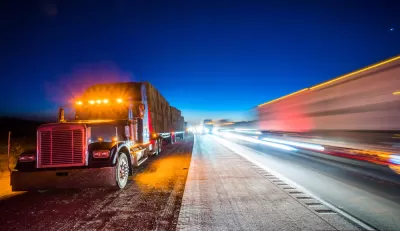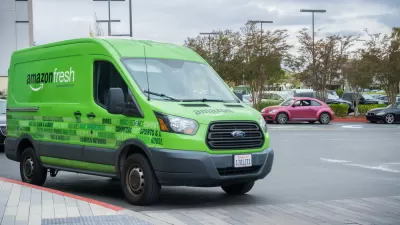A powerful lobby is more in interested in protecting its monopoly than lessening congestion and pollution.

"For many Americans, the experience of driving on a coastal highway like Interstate 5 in California can be a nightmare of dodging massive trucks hauling cargo between US cities," reports Erik Olsen.
According to Olsen, only 2 percent of domestic freight moving among the Lower 48 states moves by sea, despite the fact that about half the population lives near the coast.
The reason so much freight moves on the nation's roadways is the subject of Olsen's article, and credit goes to the Jones Act. The Jones Act, passed shortly after World War I, "preserves a monopoly for US-built, owned and operated ships to transport goods between US ports."
According to Olsen, the law was designed to protect American shipbuilding and "ensure that the US had ample ships to conduct international trade." The law didn't manage to protect the industry, however, and now "there are some 171 privately-owned US flagged ships today. Just 93 of them are Jones Act-eligible."
Thus, the consequences of the Jones Act in 2017 include higher costs for consumer goods as well as more freight on trucks. The latter, according to Olsen, "significantly increasing highways congestion, intensifying air pollution and further degrading the country’s infrastructure."
Olsen provides additional details about the consequences of the Jones Act, and discusses the business interests that have made the law virtually impossible to overturn.
FULL STORY: An arcane American law protected by powerful interests is causing insane traffic jams

Maui's Vacation Rental Debate Turns Ugly
Verbal attacks, misinformation campaigns and fistfights plague a high-stakes debate to convert thousands of vacation rentals into long-term housing.

Planetizen Federal Action Tracker
A weekly monitor of how Trump’s orders and actions are impacting planners and planning in America.

San Francisco Suspends Traffic Calming Amidst Record Deaths
Citing “a challenging fiscal landscape,” the city will cease the program on the heels of 42 traffic deaths, including 24 pedestrians.

Defunct Pittsburgh Power Plant to Become Residential Tower
A decommissioned steam heat plant will be redeveloped into almost 100 affordable housing units.

Trump Prompts Restructuring of Transportation Research Board in “Unprecedented Overreach”
The TRB has eliminated more than half of its committees including those focused on climate, equity, and cities.

Amtrak Rolls Out New Orleans to Alabama “Mardi Gras” Train
The new service will operate morning and evening departures between Mobile and New Orleans.
Urban Design for Planners 1: Software Tools
This six-course series explores essential urban design concepts using open source software and equips planners with the tools they need to participate fully in the urban design process.
Planning for Universal Design
Learn the tools for implementing Universal Design in planning regulations.
Heyer Gruel & Associates PA
JM Goldson LLC
Custer County Colorado
City of Camden Redevelopment Agency
City of Astoria
Transportation Research & Education Center (TREC) at Portland State University
Jefferson Parish Government
Camden Redevelopment Agency
City of Claremont




























